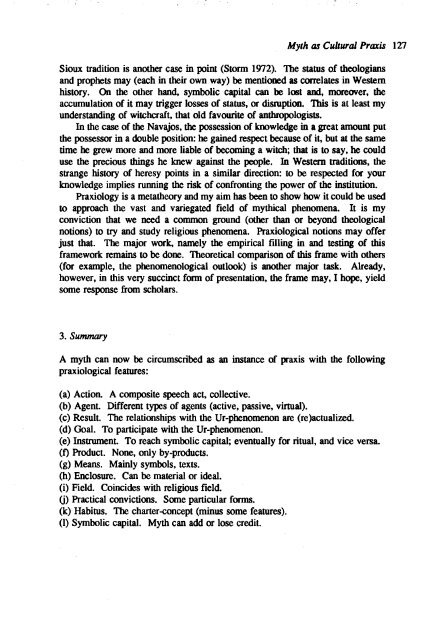1991 No. 1 CONTENTS - Institute of Social and Cultural ...
1991 No. 1 CONTENTS - Institute of Social and Cultural ...
1991 No. 1 CONTENTS - Institute of Social and Cultural ...
You also want an ePaper? Increase the reach of your titles
YUMPU automatically turns print PDFs into web optimized ePapers that Google loves.
Myth as <strong>Cultural</strong> Praxis 127<br />
Sioux tradition is another case in point (Storm 1972). The status <strong>of</strong> theologians<br />
<strong>and</strong> prophets may (each in their own way) be mentioned as correlates in Western<br />
history. On the other h<strong>and</strong>, symbolic capital can be lost <strong>and</strong>, moreover, the<br />
accumulation <strong>of</strong> it may trigger losses <strong>of</strong> status, or disruption. 'Ibis is at least my<br />
underst<strong>and</strong>ing <strong>of</strong> witchcraft, that old favourite <strong>of</strong> anthropologists.<br />
In the case <strong>of</strong> the Navajos, the possession <strong>of</strong> knowledge in a great amount put<br />
the possessor in a double position: he gained respect because <strong>of</strong> it, but at the same<br />
time he grew more <strong>and</strong> more liable <strong>of</strong> becoming a witch; that is to say, he could<br />
use the precious things he knew against the people. In Western traditions, the<br />
strange history <strong>of</strong> heresy points in a similar direction: to be respected for your<br />
knowledge implies running the risk <strong>of</strong> confronting the power <strong>of</strong> the institution.<br />
Praxiology is a metatheory <strong>and</strong> my aim has been to show how it could be used<br />
to approach the vast <strong>and</strong> variegated field <strong>of</strong> mythical phenomena. It is my<br />
conviction that we need a common ground (other than or beyond theological<br />
notions) to try <strong>and</strong> study religious phenomena. Praxiological notions may <strong>of</strong>fer<br />
just that. The major work, namely the empirical filling in <strong>and</strong> testing <strong>of</strong> this<br />
framework remains to be done. Theoretical comparison <strong>of</strong> this frame with others<br />
(for example, the phenomenological outlook) is another major task. Already,<br />
however, in this very succinct fonn <strong>of</strong> presentation, the frame may, I hope, yield<br />
some response from scholars.<br />
3. Summary<br />
A myth can now be circumscribed as an instance <strong>of</strong> praxis with the following<br />
praxiological features:<br />
(a) Action. A composite speech act, collective.<br />
(b) Agent. Different types <strong>of</strong> agents (active, passive, virtual).<br />
(c) Result. The relationships with the Ur-phenomenon are (re)actualized.<br />
(d) Goal. To participate with the Ur-phenomenon.<br />
(e) Instrument. To reach symbolic capital; eventually for ritual, <strong>and</strong> vice versa.<br />
(1) Product. <strong>No</strong>ne, only by-products.<br />
(g) Means. Mainly symbols, texts.<br />
(h) Enclosure. Can be material or ideal.<br />
(i) Field. Coincides with religious field.<br />
0) Practical convictions. Some particular forms.<br />
(k) Habitus. The charter-concept (minus some features).<br />
(I) Symbolic capital. Myth can add or lose credit.
















